Winter 2013-14 Roaming
27 Jan 2013
Blythe and Petrified Wood
Today, I elect to drive about 20 miles west from Quartzite to Blythe, then turn north on Midland Road. I’m headed for a place that Karin and I visited in an earlier trip, where we found a surprising amount of petrified wood (all on BLM land and free for the collecting).
Ralph is my steed today, and we zip over to Blythe in about 16 minutes at Arizona’s 75 (65 in CA).
 Blythe is surprising, a neat and clean town with wide streets. There are quite a few closed shops and empty buildings, but they’re well cared for, no graffiti, and the entire town presents quite nicely. This is a striking change from the rundown burgs we’ve visited across the West, with ratty collapsing buildings and dirty, depressing neighborhoods. I may have missed the junky parts of town, but what I did see was quite pleasant. Blythe is surrounded by huge spreads of agriculture, sustained no doubt by Colorado River water from a short distance east.
Blythe is surprising, a neat and clean town with wide streets. There are quite a few closed shops and empty buildings, but they’re well cared for, no graffiti, and the entire town presents quite nicely. This is a striking change from the rundown burgs we’ve visited across the West, with ratty collapsing buildings and dirty, depressing neighborhoods. I may have missed the junky parts of town, but what I did see was quite pleasant. Blythe is surrounded by huge spreads of agriculture, sustained no doubt by Colorado River water from a short distance east.
 The local aqueduct shines nicely in the afternoon sun and harmonizes well with the lush green fields it helps to foster.
The local aqueduct shines nicely in the afternoon sun and harmonizes well with the lush green fields it helps to foster.
Up Midland Road, the Midland LTVA passes on my right, and I turn off the road to the east just past the large powerline running northeast. This small road (which eventually joins the powerline road) is placarded with BLM info and guidance. Retracing our previous track, I drive past our old fire-ring (painstakingly built to a fine art by yours truly), stopping frequently to look for petrified wood.
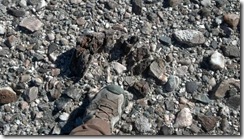 I don’t have the patience to do a “grid search”, where you map out a precise cross-hatch search pattern. So I just wander around, looking for stuff that looks like old wood. I find a few pieces, and I look carefully for geological hints as to where a concentration might be found. But it’s clear that the general arrangement of the wood is simply random scattering.
I don’t have the patience to do a “grid search”, where you map out a precise cross-hatch search pattern. So I just wander around, looking for stuff that looks like old wood. I find a few pieces, and I look carefully for geological hints as to where a concentration might be found. But it’s clear that the general arrangement of the wood is simply random scattering.
One thing that seems noteworthy is that there is occasionally a “stump” to be found, a petrified remnant of a dead tree, pretty much where it originally stood. At least, that’s the apparency. Here’s a picture of one such example, a hollowed-out partial stump curving in an arc above my foot. All turned to solid stone.
All the pieces that I do find seem to have been long-dead, and even partially rotted, before they were fossilized. Sometimes I wish I had a better background in geology (to better understand what I’m seeing) – – but that stuff, like botany, doesn’t seem to stick in my brain.
I wander around, staring intently at the ground and muttering incoherently like the Rain Man himself, occasionally picking up some odd rock hoping it’s ancient embalmed cellulose. Some are, most aren’t. I make little cairns of both small and large/heavy samples, and then whistle for Ralph to come over and help me pick them up. I have some small wire brushes that I bought at the Quartzite flea market, and I use them to sweep off the caked dirt on the bottom of the samples. They aren’t the glitzy sliced-and-polished kind of petrified wood you see in the gem stores, but they are genuine, and they’re free too.
Heading now much further up the powerline road than before, the countryside starts to change dramatically. The plain flat desert becomes scarred with dry rivulets of bygone water drainage; the road becomes twisty, rutted, rocky, and dives steeply into cross-drainages, asking for aggressive approach/departure angles of any vehicles venturing through.
 Out of nowhere, with no other similar occurrence for scores of miles, appears a charming family clump of barrel cactus. Their thorns, about the size, shape, and toughness of a tiger’s claws, defend their precious moisture from any but the most ingenious predators (Man). No tooth or claw can penetrate the defense, and even an expertly-wielded machete requires intense work to get past the barrier. In fact, hacking into a barrel cactus can make a man sweat so profusely that he loses more water than he earns by squeezing the moist pulp into his parched mouth. Perhaps this is why so many human skeletons are found near badly-scarred barrel cacti. (Yes, I’m joking.)
Out of nowhere, with no other similar occurrence for scores of miles, appears a charming family clump of barrel cactus. Their thorns, about the size, shape, and toughness of a tiger’s claws, defend their precious moisture from any but the most ingenious predators (Man). No tooth or claw can penetrate the defense, and even an expertly-wielded machete requires intense work to get past the barrier. In fact, hacking into a barrel cactus can make a man sweat so profusely that he loses more water than he earns by squeezing the moist pulp into his parched mouth. Perhaps this is why so many human skeletons are found near badly-scarred barrel cacti. (Yes, I’m joking.)
 Ralph and I reach a high, flattened knoll where one of the powerline towers is erected. These old structures are built of wood, the original creosote fading away and leaving rusty, vulnerable logs to brave the desert weather. Who knows, maybe some future explorer several million years hence will discover some petrified powerline-tower wood.
Ralph and I reach a high, flattened knoll where one of the powerline towers is erected. These old structures are built of wood, the original creosote fading away and leaving rusty, vulnerable logs to brave the desert weather. Who knows, maybe some future explorer several million years hence will discover some petrified powerline-tower wood.
The road goes another 30-40 miles to SR95 – – too much for today.
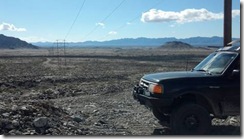 We turn back and head for camp.
We turn back and head for camp.
On the way back (to Blythe and then camp), I continue to casually look for petrified wood. But mostly, I’m just enjoying the desert vista and the sights to be found.
A huge burrow beckons, and I look down into its depths with actually a touch of trepidation. This thing is big enough for two coyotes to walk into abreast. (My hat is there for scale, not because that’s all that’s left of me.)
Off in the distance, toward some vague remnants of a camp/dwelling/?? is a quintessential desert sight: an old barrel’s wood has weathered, rotted, and washed away, leaving only the barrel hoops behind. They are ancient iron, themselves half-gone from the sun, wind, and weather.
Back on I-10, civilization makes its presence known. A Border Patrol checkpoint has been set up. They let me pass, so I guess they’re not looking for pilfered petrified wood.
Traveling with Ralph is so different from previous trips. It’s not really even fair to compare driving Ralph to riding Papoose (our piggyback motorcycle). I always knew, in general, that a 4X4 pickup would be a versatile servant, but the reality of it is even better than I imagined.
In any weather, hot/cold wet/dry, Ralph unhooks from Howie in minutes and springs easily to life, ready for any task. Need to zip off to the RV show 3 miles down the road? Of course. Uh-oh, no parking – – how about that flat spot out in the dirt, over that mound of rocks and across the deep sandwash? Good parking spot, no problem. Want to take Karin 160 miles over to Phoenix to catch a plane? Done in two hours at 75-per, smoothly, quietly, comfortably. Hey, let’s go explore the back country, navigate some rugged, rutted 4WD roads, climb some ridiculous rocky grades, and cross a few deep ravines with water, brush, rocks, and sand. Still no problem. All accomplished with little more effort than pressing the ball of my right foot gently on the gas pedal. Need to tote home a few hundred pounds of miscellaneous rocks, you bet. Done farting around for the day? Time to crank it back up to 75mph and fly home to Howie, for a nice meal, some blog writing, and a comfy bed.
And when all the work is done, Ralph goes quietly into all-neutral, engine silent and axles disconnected, and docilely rolls obediently behind Howie as he’s towed to his next venue.
What a pal.
Nurse Tree
 The desert has many stories to tell, and they seem all to be about moisture and/or heat. The “nursery tree” (palo verde) is typical, and its story tends also to give a tug at the heartstrings.
The desert has many stories to tell, and they seem all to be about moisture and/or heat. The “nursery tree” (palo verde) is typical, and its story tends also to give a tug at the heartstrings.
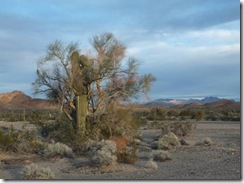 The palo verde is an unusual tree – – it has no leaves. The desert light is so intense, there’s no need for broad surfaces to catch light into sheets of chlorophyll. Instead, the very bark of the palo verde (“green tree” in Spanish) is filled lightly with chlorophyll, giving the entire structure its pale gray-green tint. The palo verde is an enigma; it always looks bereft of leaves, stark and barren – – but it also always breaks the dull gray-beige of the landscape with its lively green hue.
The palo verde is an unusual tree – – it has no leaves. The desert light is so intense, there’s no need for broad surfaces to catch light into sheets of chlorophyll. Instead, the very bark of the palo verde (“green tree” in Spanish) is filled lightly with chlorophyll, giving the entire structure its pale gray-green tint. The palo verde is an enigma; it always looks bereft of leaves, stark and barren – – but it also always breaks the dull gray-beige of the landscape with its lively green hue.
It is indeed a tree, and as such it stands from 10 to 20 feet tall, and offers shelter for a variety of desert flora and fauna. In southern climes, and often in Arizona, one of these benficiaries is the big saguaro, the tall, cylindrical cactus with accordion folds and multiple branching arms. As a tiny seedling, the saguaro flourishes under the care of the palo verde, getting shelter from the wind and just the right amount of light. But, as the saguaro matures, its surface-based root system enlarges, bigger and bigger as the fattening cigar grows up through the branches of its “nurse”. Eventually, the deeper root system of the palo verde no longer receives any water, because the saguaro intercepts the seepage before it can work below the surface. The palo verde dies of thirst, and the saguaro stands alone, strong and tough from the sacrifice of its now-deceased nurse. Seems kind of sad, if you think of it human terms – – a poignant metaphor of a mother dying for her child, in the extreme. But really now – – – it’s just plants, biology, and yet another slice of desert life. Don’t cry.
28 January 2013
Option Day
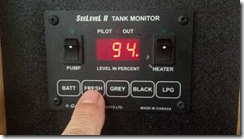 This morning, I woke rested, refreshed, and formulating a master plan. I would arise, do the morning ritual (bathroom, coffee, email, breakfast, vitamins, etc.), and then tidy up and launch. I would hook up Ralph, drive to town, get gas in Howie, fill Howie’s spare gas cans, go to the RV Pit Stop and dump-and-fill, then boogie up the road to a spot near Lake Mohave and spend a night there.
This morning, I woke rested, refreshed, and formulating a master plan. I would arise, do the morning ritual (bathroom, coffee, email, breakfast, vitamins, etc.), and then tidy up and launch. I would hook up Ralph, drive to town, get gas in Howie, fill Howie’s spare gas cans, go to the RV Pit Stop and dump-and-fill, then boogie up the road to a spot near Lake Mohave and spend a night there.
WRONG. That’s a working person’s way of thinking. Let’s relax like a proper retired guy, lest I receive a reprimand from the RP (Retirement Police).
So, scrap that plan – – instead, I kick back and look at some maps over a second cup of coffee. Howie and I then casually roll into town, do the gas-dump-fill thing, and leisurely head back to camp. Good decision, Greg – – by the time we say hi to Ralph again, it’s after noon. In the meanwhile, I’ve busted a sewer fitting and would like to go to an RV shop to replace it. No rush to do so – – but there are probably 10 RV shops within 3 miles, so no time like the present.
Into Each Life a Little Rain Must Fall
While I was doing Howie’s thing at the dump/fill facility, I noticed that they were especially busy, with long waits. I found out that 2 of their 4 dump stations were out of service due to a “clogged pump”. The mind reels at any attempt to visualize what a clogged sewer drain pump must look like, sound like, and be like to remove and repair/replace. Scurrying around the disabled area were two workmen, in clear states of stress and distress. They were wearing coveralls, and those coveralls were – – well, it’s kind of hard to describe. Liken it to wearing a neck-to-ankle garment made from dried-up used toilet paper. That’s as gentle as I can be about it. Don’t worry, I took no pictures. I was afraid they might smile, and I don’t want to think what that might look like.
If you EVER think you have a tough job, think again. Not a fun day here for some folk.
After finishing my “chores”, I found a few last sights worth sharing from Quartzite.
Above is a metal sculpture, though you wouldn’t know it from casual inspection. It’s about 30 feet high, on private property. Couldn’t get closer.
Next, ample evidence of the intellectual level of crowds. This warning was just outside a fast- food stand.
Contrasts
Usually, the desert sun is ubiquitous, and one quickly gets used to dealing with its pervasive heat and glare. Find shade, stay hydrated, use sunscreen – – the mantra of the desert dweller or traveler. Then, there are days like today. Morning was balmy, but the forecast cold front soon delivered increasing clouds and a chill, biting north wind. Outside temps dropped 15 degrees in an hour, and all across the campgrounds and show areas, shoulders hunched and zippers zipped, with people universally grimacing against the harshness.
Late this afternoon, the capricious sun generously dips below the base of the overcast. Warm, golden light floods the camp and everything casts off its somber grayness and comes to life. Nobody grabs for the water bottle or sunscreen; we all just seek out a nice spot to shelter from the wind and soak up the warmth. It is all too fleeting – – the western hills, and clouds on the horizon, meanly intercept the gentle beams; they fade, flicker, and are no more. Dark cold shadows fall again, and a chilly, breezy evening envelopes us all. I am so happy that I filled up with propane today :o)
This evening, before dinner, I get everything ready for tomorrow’s departure. Howie and Ralph are quite eager to go see new sights.
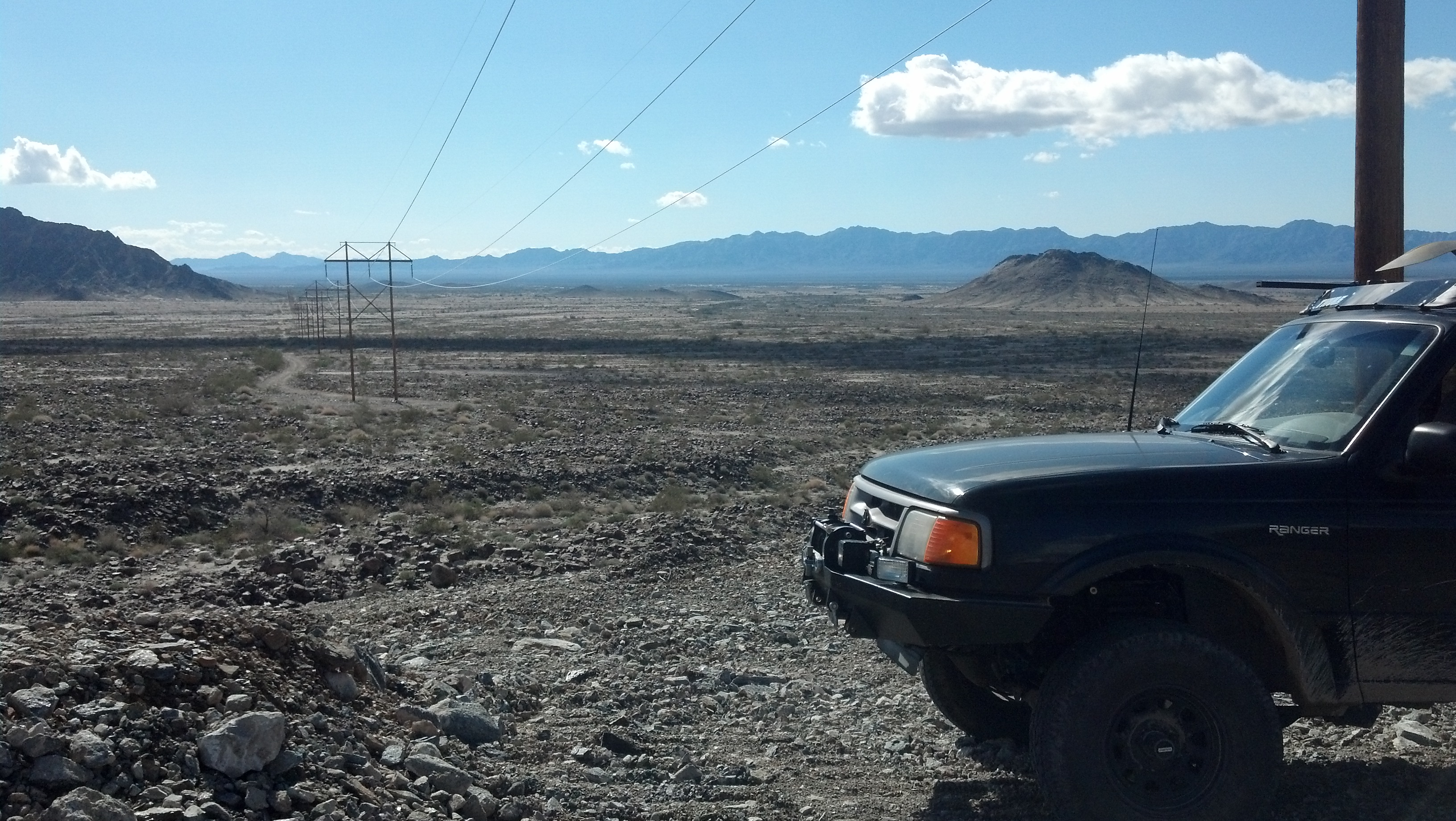

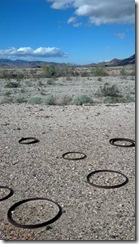
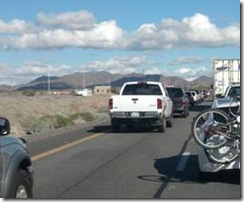
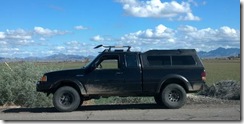
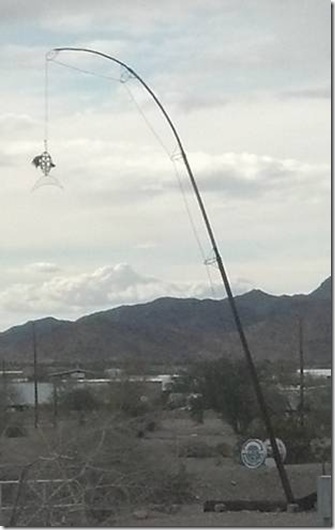

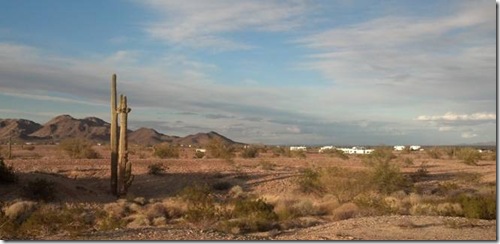

Comments
Winter 2013-14 Roaming — No Comments
HTML tags allowed in your comment: <a href="" title=""> <abbr title=""> <acronym title=""> <b> <blockquote cite=""> <cite> <code> <del datetime=""> <em> <i> <q cite=""> <s> <strike> <strong>